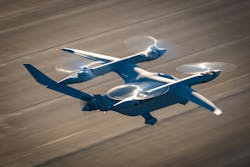BETA Technologies collaborates with Near Earth Autonomy on for defense and commercial eVTOL autonomous operations
Questions and Answers:
What are BETA Technologies and Near Earth Autonomy collaborating on? They are working together to integrate advanced perception, guidance, and autonomous flight capabilities into BETA’s electric aircraft.
When does BETA expect autonomous flight testing to begin? The company anticipates starting flight tests in the first half of 2026.
What types of missions are BETA’s aircraft intended to support? The aircraft are designed for defense, cargo, logistics, medical transport, and passenger operations.
SOUTH BURLINGTON, Vt. - BETA Technologies Inc. in South Burlington, Vt. is expanding the autonomous capabilities of its electric and hybrid vertical-takeoff-and-landing aircraft to support a wider set of defense and commercial missions. The company is working with Near Earth Autonomy in Pittsburgh to advance development and integration efforts.
BETA’s electric and hybrid VTOL aircraft use fly-by-wire flight controls designed to support both crewed and uncrewed operations. The company has been developing autonomous technologies for several years and has flown more than 1,000 hours of uncrewed sorties on subscale aircraft, demonstrating a range of more than 158 nautical miles on a single charge. Near Earth contributes expertise in perception, guidance, path planning, and certifiable autonomous systems for military and industry programs.
Related: Near Earth Autonomy extends autonomy to large-scale VTOL aircraft
The companies have completed initial integration of Near Earth’s perception and guidance systems into BETA’s fly-by-wire architecture. BETA expects flight testing to begin in the first half of 2026.
"Increasing our autonomy capabilities will deliver even greater optionality to operators, including faster speed, higher payload, longer range, and optional piloting," said Shawn Hall, BETA’s chief revenue officer. "In order to meet the demands of the defense and civil sectors today, mobility platforms must be smarter, more flexible, and ready to operate where traditional systems can’t. Recent announcements from the Department of Transportation and Department of War both point towards the accelerated fielding of autonomous aircraft. We are excited to be at the center of this effort with both civil and military customers."
Muli-mission
BETA’s autonomy development supports future operations for military users and commercial logistics customers such as UPS, Bristow, and e-Smart Logistics.
"This collaboration builds on Near Earth’s proven work of bringing Responsive Uncrewed Capability to helicopters, such as converting the UH-60L Black Hawk to the RUC-60 to enable operations without onboard pilots," said Sanjiv Singh, CEO of Near Earth Autonomy. "By leveraging the technology foundation, operational experience, and certification groundwork established through the RUC-60 program, we will help integrate advanced autonomy into ALIA to enable safe, efficient, and scalable operations across a wide range of missions."
BETA aircraft are designed for defense, cargo, logistics, medical, and passenger operations, with a piloted payload capacity of up to 1,240 pounds or five passengers. Federal initiatives supporting advanced air mobility include the U.S. Department of Transportation’s Electric Vertical Takeoff and Landing Integration Pilot Program and new directives focused on defense acquisition modernization and critical technology areas. BETA says these actions are accelerating its work in autonomous flight.
BETA designs and manufactures electric aircraft, propulsion systems, components, and charging systems. Its ALIA family includes both fixed-wing electric aircraft and electric VTOL models, which have flown across the United States on multiple occasions.
About the Author
Jamie Whitney
Senior Editor
Jamie Whitney joined the staff of Military & Aerospace Electronics in 2018 and oversees editorial content and produces news and features for Military & Aerospace Electronics, attends industry events, produces Webcasts, and oversees print production of Military & Aerospace Electronics.
